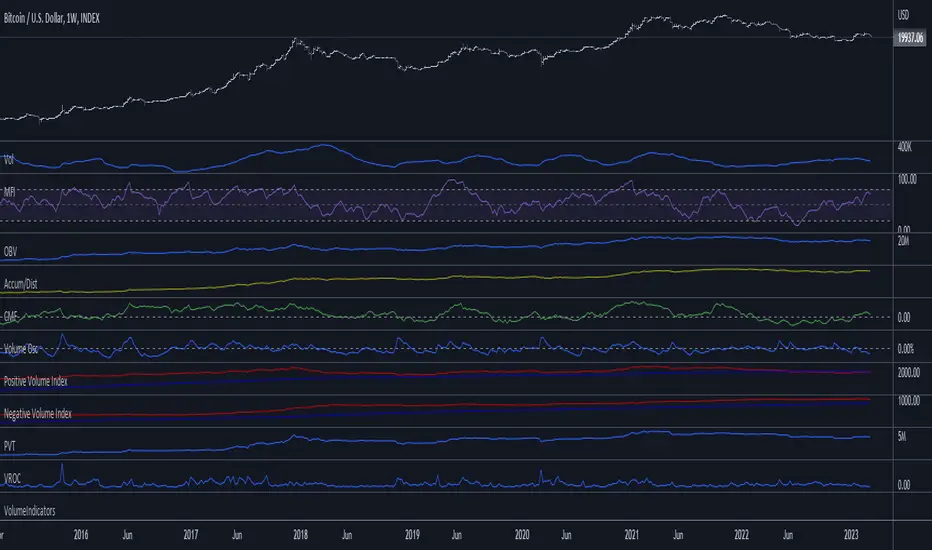VolumeIndicators

This is a library of 'Volume Indicators'.
It aims to facilitate the grouping of this category of indicators, and also offer the customized supply of the source, not being restricted to just the closing price.
Indicators:
1. Volume Moving Average (VMA):
Moving average of volume. Identify trends in trading volume.
2. Money Flow Index (MFI): Measures volume pressure in a range of 0 to 100.
Calculates the ratio of volume when the price goes up and when the price goes down
3. On-Balance Volume (OBV):
Identify divergences between trading volume and an asset's price.
Sum of trading volume when the price rises and subtracts volume when the price falls.
4. Accumulation/Distribution (A/D):
Identifies buying and selling pressure by tracking the flow of money into and out of an asset based on volume patterns.
5. Chaikin Money Flow (CMF):
A variation of A/D that takes into account the daily price variation and weighs trading volume accordingly.
6. Volume Oscillator (VO):
Identify divergences between trading volume and an asset's price. Ratio of change of volume, from a fast period in relation to a long period.
7. Positive Volume Index (PVI):
Identify the upward strength of an asset. Volume when price rises divided by total volume.
8. Negative Volume Index (NVI):
Identify the downward strength of an asset. Volume when price falls divided by total volume.
9. Price-Volume Trend (PVT):
Identify the strength of an asset's price trend based on its trading volume. Cumulative change in price with volume factor
vma(length, maType, almaOffset, almaSigma, lsmaOffSet)
description Volume Moving Average (VMA)
Parameters:
length: (int) Length for moving average
maType: (int) Type of moving average for smoothing
almaOffset: (float) Offset for Arnauld Legoux Moving Average
almaSigma: (float) Sigma for Arnauld Legoux Moving Average
lsmaOffSet: (float) Offset for Least Squares Moving Average
Returns: (float) Moving average of Volume
mfi(source, length)
description MFI (Money Flow Index).
Uses both price and volume to measure buying and selling pressure in an asset.
Parameters:
source: (float) Source of series (close, high, low, etc.)
length
Returns: (float) Money Flow series
obv(source)
description On Balance Volume (OBV)
Same as ta.obv(), but with customized type of source
Parameters:
source: (float) Series
Returns: (float) OBV
ad()
description Accumulation/Distribution (A/D)
Returns: (float) Accumulation/Distribution (A/D) series
cmf(length)
description CMF (Chaikin Money Flow).
Measures the flow of money into or out of an asset over time, using a combination of price and volume, and is used to identify the strength and direction of a trend.
Parameters:
length
Returns: (float) Chaikin Money Flow series
vo(shortLen, longLen, maType, almaOffset, almaSigma, lsmaOffSet)
description Volume Oscillator (VO)
Parameters:
shortLen: (int) Fast period for volume
longLen: (int) Slow period for volume
maType: (int) Type of moving average for smoothing
almaOffset
almaSigma
lsmaOffSet
Returns: (float) Volume oscillator
pvi(source)
description Positive Volume Index (PVI)
Same as ta.pvi(), but with customized type of source
Parameters:
source: (float) Series
Returns: (float) PVI
nvi(source)
description Negative Volume Index (NVI)
Same as ta.nvi(), but with customized type of source
Parameters:
source: (float) Series
Returns: (float) PVI
pvt(source)
description Price-Volume Trend (PVT)
Same as ta.pvt(), but with customized type of source
Parameters:
source: (float) Series
Returns: (float) PVI
Added:
vroc(length)
description Volume Rate of Change (VROC).
Uses ROC (Rate of Change) to measures the percentage change in volume of an asset over a specified time period.
Parameters:
length: [int] Period of loopback
Returns: (float) Series of VROC
Libreria Pine
In pieno spirito TradingView, l'autore ha pubblicato questo codice Pine come libreria open-source in modo che altri programmatori Pine della nostra comunità possano riutilizzarlo. Complimenti all'autore! È possibile utilizzare questa libreria privatamente o in altre pubblicazioni open-source, ma il riutilizzo di questo codice in una pubblicazione è regolato dal nostro Regolamento.
⚡Bitcoin Lightning: forwardocean64@walletofsatoshi.com
🟠Bitcoin: bc1qv0j28wjsg6l8fdkphkmgfz4f55xpph893q0pdh
🔵PayPal: paypal.com/donate/?hosted_button_id=D9KRKY5HMSL9S
Declinazione di responsabilità
Libreria Pine
In pieno spirito TradingView, l'autore ha pubblicato questo codice Pine come libreria open-source in modo che altri programmatori Pine della nostra comunità possano riutilizzarlo. Complimenti all'autore! È possibile utilizzare questa libreria privatamente o in altre pubblicazioni open-source, ma il riutilizzo di questo codice in una pubblicazione è regolato dal nostro Regolamento.
⚡Bitcoin Lightning: forwardocean64@walletofsatoshi.com
🟠Bitcoin: bc1qv0j28wjsg6l8fdkphkmgfz4f55xpph893q0pdh
🔵PayPal: paypal.com/donate/?hosted_button_id=D9KRKY5HMSL9S